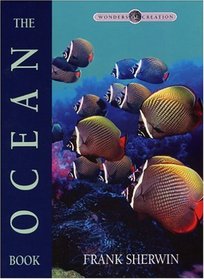I was thrilled when a friend gave me this book as I had been wanting it for quite some time. We homeschool and I'm always looking for great materials to use as part of our educational curriculum.
The book pretty much covers all the material an elementary or even junior high age student would need to know about the ocean and the author used a cross-topical approach to the material. In other words, he integrated information, statistics, and supplemental material from other subjects as well. As students learn about oceanic ridges, hydrothermal vents, tides, the oceanic food chain, etc., they're also learning vocabulary, science, geology, geography, math, nutrition, and more. There are maps, diagrams, photographs, and drawings.
All the diversity makes the book appealing to learners of all ages and learning styles.
There is a chapter called "The Genesis Flood." In my opinion, a book about the ocean wouldn't be complete without a mention of this event. What I like about it is the fact that this is not simply another book that mentions the flood and expects you to accept it as fact. The author has actually taken the time to evaluate various arguments for a worldwide flood and examine them from a scientific point of view.
Finally, I really appreciated the conversion charts at the back of the book. This was quite helpful when discussing nautical terms like "fathoms" with my students - my children.
I would highly recommend this book for anyone, but especially for educators wanting to provide their students with some excellent educational material that will hold their interest. This book is ideal for any unit study or homeschool curricula regarding the ocean. You could use it independently or find some fantastic supplemental material in the teacher's guide.
Sonya Haskins, author of Homeschooling for the Rest of Us (Bethany House, 2010)
The book pretty much covers all the material an elementary or even junior high age student would need to know about the ocean and the author used a cross-topical approach to the material. In other words, he integrated information, statistics, and supplemental material from other subjects as well. As students learn about oceanic ridges, hydrothermal vents, tides, the oceanic food chain, etc., they're also learning vocabulary, science, geology, geography, math, nutrition, and more. There are maps, diagrams, photographs, and drawings.
All the diversity makes the book appealing to learners of all ages and learning styles.
There is a chapter called "The Genesis Flood." In my opinion, a book about the ocean wouldn't be complete without a mention of this event. What I like about it is the fact that this is not simply another book that mentions the flood and expects you to accept it as fact. The author has actually taken the time to evaluate various arguments for a worldwide flood and examine them from a scientific point of view.
Finally, I really appreciated the conversion charts at the back of the book. This was quite helpful when discussing nautical terms like "fathoms" with my students - my children.
I would highly recommend this book for anyone, but especially for educators wanting to provide their students with some excellent educational material that will hold their interest. This book is ideal for any unit study or homeschool curricula regarding the ocean. You could use it independently or find some fantastic supplemental material in the teacher's guide.
Sonya Haskins, author of Homeschooling for the Rest of Us (Bethany House, 2010)




